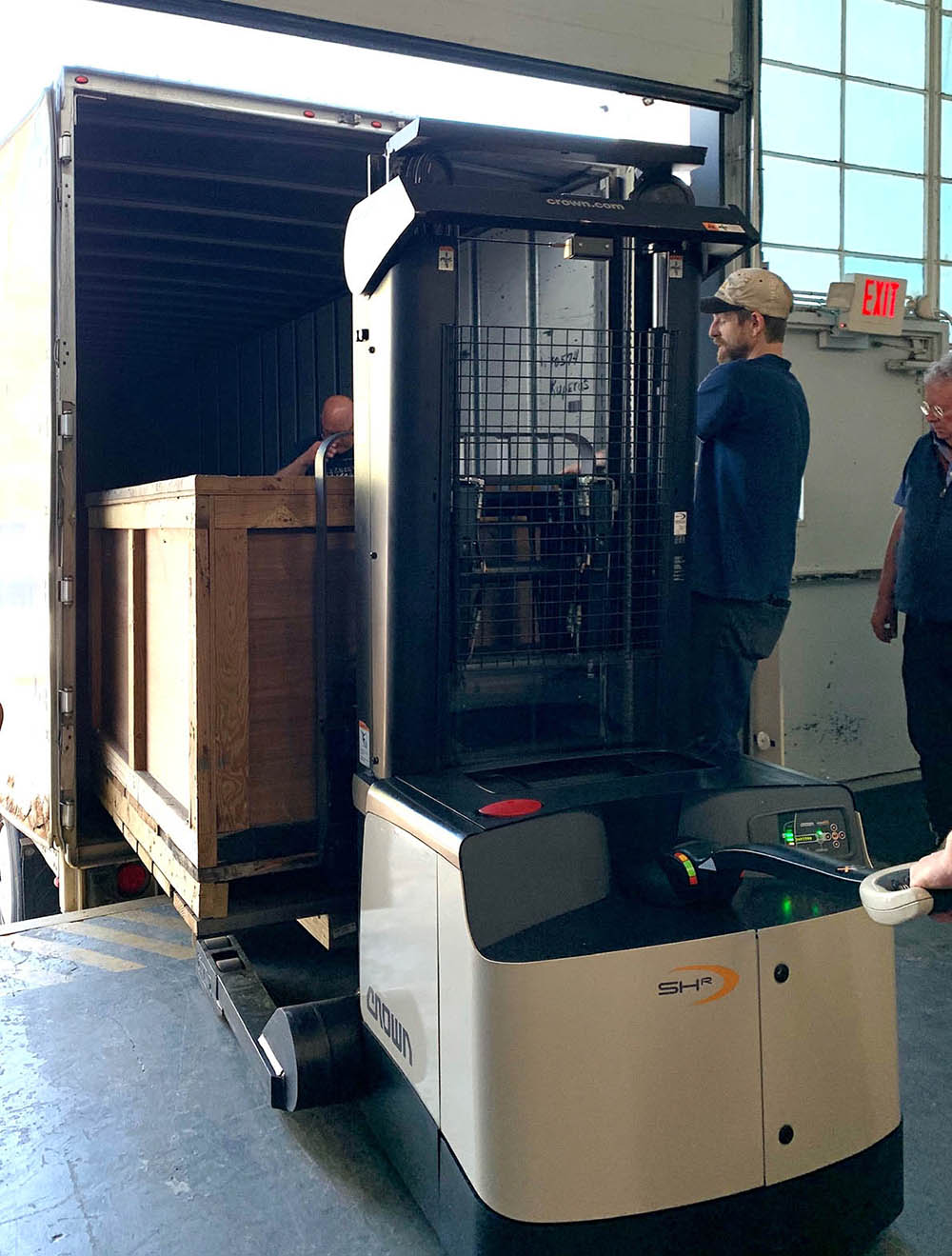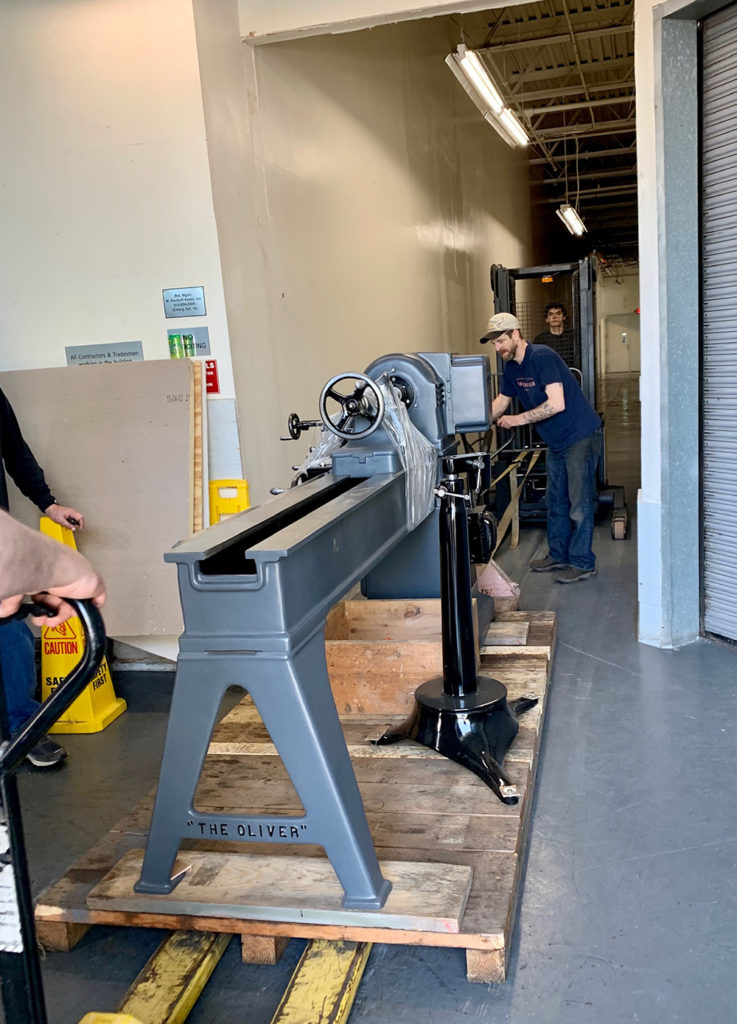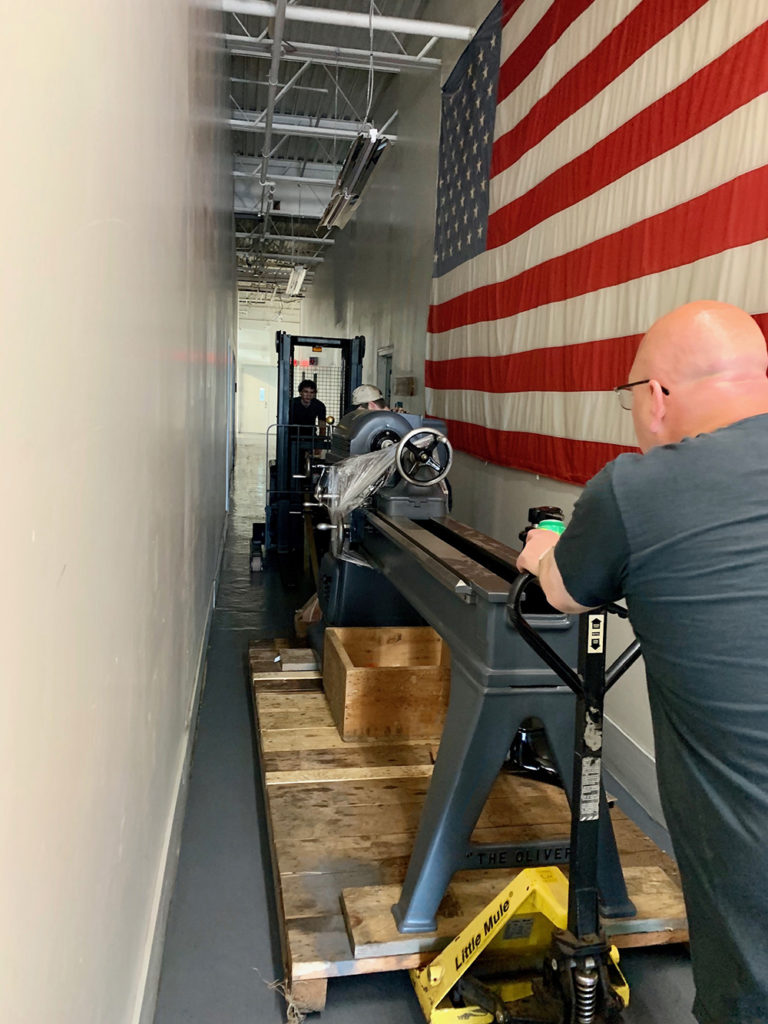While there are few things more exciting than moving into a new space it always comes with certain challenges. When your hallway is long and narrow and your machines weigh over 3000 lbs. and are measure over 8’ tall and 8’ long the challenges become greater. Fortunately, the people at The Plumier Foundation never back down from a challenge. Having looked for a place to settle for nearly 18 months the excitement of finally being able to move in outweighed even the greatest of these challenges.
The 19th century ornamental turning lathes had all been moved in just as the COVID-19 situation started; however, the cabinetmaking equipment was scheduled to be delivered the Wednesday after the lockdown was announced causing even a longer delay. Adding this to the fact that the machinery had been in the process of being restored for over 2 years, all involved carried a spirit of celebration beyond description.
Initial measurements indicated that the doorway to the hall was too low to fit the Yates-American 36” “Snowflake” band saw. Fortunately the building owner accommodated us and altered the doorway as tipping a 3000 pound saw that’s 8’ 4” tall enough to fit through would have been virtually impossible given the equipment we have at our disposal. Fortunately, the height of the doorway and width of the hallway could be measured ahead of time and the crating made in accordance. With a couple of the machines the width was such that they had to be uncrated before being brought down the hallway, and even then there were only inches to spare.
Another challenge that came up was that the truck was about 8” higher than the loading dock, and some pallets were too long to pick up solely with the walk behind forklift. However, the crew put their heads together and met each challenge taking their time at every step to insure the safety of the equipment and especially those moving it.
All of the cabinetmaking equipment was restored and provided by Warner Machinery and was brought out from Indiana. Darcy Warner, owner, completely filled the semi trailer with our machines and coordinated their travel so as to meet the truck at unloading time. Darcy handled the equipment with all of the care that he put into restoring it. Each machine had been completely dismantled and rebuilt from the bottom up. Tables were even reground to bring them back to better than new condition, so with fresh paint and table tops so smooth they had reflective surfaces he made each step with caution. Darcy was assisted by his daughter who worked with him in such a manner that tasks almost appeared to have been choreographed. It was obvious that they have spent many hours working together and carry a lot of mutual respect. Such is a rare sight today, and it added to the pleasure of the move.
By early afternoon on the first day all the machines were off of the truck and in the shop. Then came a sort of “musical machines” game where we moved machines from place to place until we found a placement that had work flow and efficiency in mind. Of course we had a plan before we started but only two machines ended where they were first proposed to planted. By the end of the first day the decisions had been made. On the second day the rest of the uncrating was done and the machines were all set on the floor off of the pallets. Not always an easy task.
While not particularly heavy compared to some of the other machines, the most awkward of the machines to move in was the Murphy-Rogers dust collector. It stands 13’ tall and has a foot print of 5’x7’ with much of its weight at the top. Since the fork lift could not reach high enough some clever rigging was required along with a lot of hands to get it standing.
Once the machines were set on the floor Darcy went about assembling the parts that had been taken off to ensure safety during travel. The Plumier staff, the volunteers, Darcy, and his daughter all work at seemingly a frenetic pace driven by the excitement of the day and the enchantment of seeing all the machines come together in their new and permanent home. By the end of the second day all the machines were set up and ready to be run except for the piping for the dust collection which could not be ordered until the machines were placed. While it was an exhausting couple of days, all involved stood taller than they did before the move despite being exhausted.
With the machines in place, now the real work begins.

The Yates American 22” jointer being removed from the trailer. Notice the 8” step down from the truck to the dock. This jointer is over 8’ long and weighs over 2500 lbs. We used a pallet jack inside the trailer and pulled the crate out using the fork lift. When to the edge we cribbed it up and let the pallet down board by board.

The crate was removed during the process to make the machine less unwieldy.

Once in the room it was left on the pallet until its final location was assured.

The Yates American 22” jointer in position, all 8’ of it.

The Oliver 25B lathe gave different challenges. It was packed in such a way that it had to be pulled out a ways in order to get a pallet jack in behind it. With pipes under the pallet the fork lift handled it readily.
The lathe itself is over 8’ long and weighs well over a ton. Making the step down was a challenge, but having already met the same challenge before I went readily.
They say many hands make light work, but we’re not so sure any amount of hands would make moving this lathe light work.
The hallway is long and narrow. Two pallet jacks carried the weight while the fork lift pulled it. Making the corner at the other end would be a challenge too.
The trip down the hallway goes smoothly but very slow. With steering at the front and rear it was easy to avoid the walls.

With the Martin T17 in the foreground the Oliver Lathe was where we thought it would go; however, We were not as yet certain so we left it on the pallet for the mean time.

This lathe has an imposing presence and demands admiration.

The Northfield Uni-Point saw seemed easy to unload in comparison.

Northfield Uni-Saw in place.

Oliver Mortiser still on pallet but generally in place.

The walk behind fork lift made quick and easy work of the Yates American 16” band saw.

Here the Yates American 16” saw peeks out of its cage.

The Yates American Y16 saw in place. It has a handle and wheels so it can be pulled around like a little red wagon.

The Yates American Y36 band saw was not so easy. The table and upper wheel had to be removed to get it through the door, and that was after the door was altered!

It took a crate the size of a full pallet to transport the upper wheel and guard.

The Y36 band saw moved easily enough into the room, but it would take a bit of magic to get it on the ground.

The Bauerle 28” planer is in the forground for perspective. The immense size of the saw can be seen all the way across the room. For perspective, the man standing next to the saw is 6’3” tall.

The Bauerle 28” planer coming off of the truck.

The bed on the Baurle planer is so smoothly ground it is reflective.

The Bauerle 28” planer in place.

The Martin T17 table saw waiting to be placed with Holtzapffel #2195 in the background.



